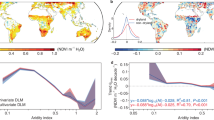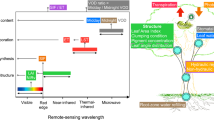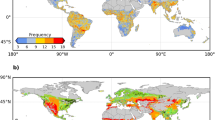Abstract
Vegetation dynamics are affected not only by the concurrent climate but also by memory-induced lagged responses. For example, favourable climate in the past could stimulate vegetation growth to surpass the ecosystem carrying capacity, leaving an ecosystem vulnerable to climate stresses. This phenomenon, known as structural overshoot, could potentially contribute to worldwide drought stress and forest mortality but the magnitude of the impact is poorly known due to the dynamic nature of overshoot and complex influencing timescales. Here, we use a dynamic statistical learning approach to identify and characterize ecosystem structural overshoot globally and quantify the associated drought impacts. We find that structural overshoot contributed to around 11% of drought events during 1981–2015 and is often associated with compound extreme drought and heat, causing faster vegetation declines and greater drought impacts compared to non-overshoot related droughts. The fraction of droughts related to overshoot is strongly related to mean annual temperature, with biodiversity, aridity and land cover as secondary factors. These results highlight the large role vegetation dynamics play in drought development and suggest that soil water depletion due to warming-induced future increases in vegetation could cause more frequent and stronger overshoot droughts.
This is a preview of subscription content, access via your institution
Access options
Access Nature and 54 other Nature Portfolio journals
Get Nature+, our best-value online-access subscription
$29.99 / 30 days
cancel any time
Subscribe to this journal
Receive 12 digital issues and online access to articles
$119.00 per year
only $9.92 per issue
Buy this article
- Purchase on Springer Link
- Instant access to full article PDF
Prices may be subject to local taxes which are calculated during checkout





Similar content being viewed by others
Data availability
The NDVI 3gv1 dataset is available at http://poles.tpdc.ac.cn/en/data/9775f2b4-7370-4e5e-a537-3482c9a83d88/, the CRU climate dataset is available at https://crudata.uea.ac.uk/cru/data/hrg/, the GPCC precipitation data are available at https://www.dwd.de/EN/ourservices/gpcc/gpcc.html, phenology metrics derived from MODIS are available at https://vip.arizona.edu/viplab_data_explorer.php, the SPEI dataset is available at https://spei.csic.es/database.html, the ERA5 soil moisture data are available at https://cds.climate.copernicus.eu/cdsapp#!/dataset/reanalysis-era5-land-monthly-means and the SoMo.ml soil moisture data are from https://www.bgc-jena.mpg.de/geodb/projects/Home.php. The source data for the figures are publicly available at https://doi.org/10.6084/m9.figshare.15086535.
Code availability
The codes for the DLM and overshoot identification are available at https://github.com/zhangyaonju/Overshoot/.
References
Allen, C. D. et al. A global overview of drought and heat-induced tree mortality reveals emerging climate change risks for forests. For. Ecol. Manag. 259, 660–684 (2010).
Ciais, P. et al. Europe-wide reduction in primary productivity caused by the heat and drought in 2003. Nature 437, 529–533 (2005).
Zhao, M. & Running, S. W. Drought-induced reduction in global terrestrial net primary production from 2000 through 2009. Science 329, 940–943 (2010).
Orth, R. & Destouni, G. Drought reduces blue-water fluxes more strongly than green-water fluxes in Europe. Nat. Commun. 9, 3602 (2018).
Doughty, C. E. et al. Drought impact on forest carbon dynamics and fluxes in Amazonia. Nature 519, 78–82 (2015).
Schwalm, C. R. et al. Reduction in carbon uptake during turn of the century drought in western North America. Nat. Geosci. 5, 551–556 (2012).
Bastos, A. et al. Direct and seasonal legacy effects of the 2018 heat wave and drought on European ecosystem productivity. Sci. Adv. 6, eaba2724 (2020).
Wolf, S. et al. Warm spring reduced carbon cycle impact of the 2012 US summer drought. Proc. Natl Acad. Sci. USA 113, 5880–5885 (2016).
Jump, A. S. et al. Structural overshoot of tree growth with climate variability and the global spectrum of drought‐induced forest dieback. Glob. Change Biol. 23, 3742–3757 (2017).
Buermann, W. et al. Widespread seasonal compensation effects of spring warming on northern plant productivity. Nature 562, 110–114 (2018).
Goulden, M. L. & Bales, R. C. California forest die-off linked to multi-year deep soil drying in 2012–2015 drought. Nat. Geosci. 12, 632–637 (2019).
West, M. & Harrison, J. Bayesian Forecasting and Dynamic Models (Springer, 1997).
Pinzon, J. E. & Tucker, C. J. A non-stationary 1981–2012 AVHRR NDVI3g time series. Remote Sens. 6, 6929–6960 (2014).
Nemani, R. R. Climate-driven increases in global terrestrial net primary production from 1982 to 1999. Science 300, 1560–1563 (2003).
Zhang, X., Friedl, M. A., Schaaf, C. B. & Strahler, A. H. Climate controls on vegetation phenological patterns in northern mid and high latitudes inferred from MODIS data. Glob. Change Biol. 10, 1133–1145 (2004).
Zeng, Z. et al. Impact of earth greening on the terrestrial water cycle. J. Clim. 31, 2633–2650 (2018).
Vicente-Serrano, S. M. et al. Response of vegetation to drought time-scales across global land biomes. Proc. Natl Acad. Sci. USA 110, 52–57 (2013).
Anderegg, W. R. L. et al. Hydraulic diversity of forests regulates ecosystem resilience during drought. Nature 561, 538–541 (2018).
Isbell, F. et al. Biodiversity increases the resistance of ecosystem productivity to climate extremes. Nature 526, 574–577 (2015).
Lian, X. et al. Partitioning global land evapotranspiration using CMIP5 models constrained by observations. Nat. Clim. Change 8, 640–646 (2018).
Zscheischler, J. et al. Future climate risk from compound events. Nat. Clim. Change 8, 469–477 (2018).
Zscheischler, J. et al. A typology of compound weather and climate events. Nat. Rev. Earth Environ. 1, 333–347 (2020).
Zhou, S., Zhang, Y., Williams, A. P. & Gentine, P. Projected increases in intensity, frequency, and terrestrial carbon costs of compound drought and aridity events. Sci. Adv. 5, eaau5740 (2019).
Hersbach, H. et al. The ERA5 global reanalysis. Q. J. R. Meteorol. Soc. 146, 1999–2049 (2020).
Sungmin, O. & Orth, R. Global soil moisture data derived through machine learning trained with in-situ measurements. Sci. Data 8, 170 (2021).
Pendergrass, A. G. et al. Flash droughts present a new challenge for subseasonal-to-seasonal prediction. Nat. Clim. Change 10, 191–199 (2020).
Otkin, J. A. et al. Flash droughts: a review and assessment of the challenges imposed by rapid-onset droughts in the United States. Bull. Am. Meteorol. Soc. 99, 911–919 (2018).
Lian, X. et al. Summer soil drying exacerbated by earlier spring greening of northern vegetation. Sci. Adv. 6, eaax0255 (2020).
Green, J. K. et al. Regionally strong feedbacks between the atmosphere and terrestrial biosphere. Nat. Geosci. 10, 410–414 (2017).
Keenan, T. F. & Richardson, A. D. The timing of autumn senescence is affected by the timing of spring phenology: implications for predictive models. Glob. Change Biol. 21, 2634–2641 (2015).
Zani, D., Crowther, T. W., Mo, L., Renner, S. S. & Zohner, C. M. Increased growing-season productivity drives earlier autumn leaf senescence in temperate trees. Science 370, 1066–1071 (2020).
Buitenwerf, R., Rose, L. & Higgins, S. I. Three decades of multi-dimensional change in global leaf phenology. Nat. Clim. Change 5, 364–368 (2015).
Douville, H., Ribes, A., Decharme, B., Alkama, R. & Sheffield, J. Anthropogenic influence on multidecadal changes in reconstructed global evapotranspiration. Nat. Clim. Change 3, 59–62 (2013).
Asrar, G., Fuchs, M., Kanemasu, E. T. & Hatfield, J. L. Estimating absorbed photosynthetic radiation and leaf area index from spectral reflectance in wheat. Agron. J. 76, 300–306 (1984).
Chen, J. M. & Cihlar, J. Retrieving leaf area index of boreal conifer forests using Landsat TM images. Remote Sens. Environ. 55, 153–162 (1996).
Piao, S. et al. Characteristics, drivers and feedbacks of global greening. Nat. Rev. Earth Environ. 1, 14–27 (2020).
Becker, A. et al. A description of the global land-surface precipitation data products of the Global Precipitation Climatology Centre with sample applications including centennial (trend) analysis from 1901–present. Earth Syst. Sci. Data 5, 71–99 (2013).
Sun, Q. et al. A review of global precipitation data sets: data sources, estimation, and intercomparisons. Rev. Geophys. 56, 79–107 (2018).
Harris, I., Osborn, T. J., Jones, P. & Lister, D. Version 4 of the CRU TS monthly high-resolution gridded multivariate climate dataset. Sci. Data 7, 109 (2020).
Vicente-Serrano, S. M., Beguería, S. & López-Moreno, J. I. A multiscalar drought index sensitive to global warming: the standardized precipitation evapotranspiration index. J. Clim. 23, 1696–1718 (2010).
Harrison, P. J. & Stevens, C. F. Bayesian forecasting. J. R. Stat. Soc. B 38, 205–247 (1976).
Liu, Y., Kumar, M., Katul, G. G. & Porporato, A. Reduced resilience as an early warning signal of forest mortality. Nat. Clim. Change 9, 880–885 (2019).
Humphrey, V., Gudmundsson, L. & Seneviratne, S. I. Assessing global water storage variability from grace: trends, seasonal cycle, subseasonal anomalies and extremes. Surv. Geophys. 37, 357–395 (2016).
Schwalm, C. R. et al. Global patterns of drought recovery. Nature 548, 202–205 (2017).
Acknowledgements
Y.Z. and T.F.K. acknowledge support from the NASA IDS Award NNH17AE861. T.F.K. acknowledges additional support from the US Department of Energy (DOE) under contract DE-AC02-05CH11231 as part of the RuBiSCo SFA, a DOE Early Career Research Program award no. DE-SC0021023 and an NSF PREEVENTS award no. 1854945. We thank R. Orth for providing the SoMo.ml soil moisture data and V. Humphrey for providing the GRACEτ data. We thank Y. Liu for discussion on DLM.
Author information
Authors and Affiliations
Contributions
Y.Z. and T.F.K. conceived the idea. Y.Z. designed the study, performed the analysis and wrote the manuscript. T.F.K. and S.Z. discussed and commented on the results and the manuscript.
Corresponding authors
Ethics declarations
Competing interests
The authors declare no competing interests.
Additional information
Peer review information Nature Ecology & Evolution thanks Jesús Julio Camarero, Rene Orth and Miguel Zavala for their contribution to the peer review of this work. Peer reviewer reports are available.
Publisher’s note Springer Nature remains neutral with regard to jurisdictional claims in published maps and institutional affiliations.
Extended data
Extended Data Fig. 1 Framework of DLM.
The DLM is composed of five terms, that is, temperature component, precipitation component, direct and lagged vegetation components from previous months, trend component, and seasonal components. Numbers in the dashed box indicate the previous months used to calculate anomalies for NDVI, precipitation and temperature. The three seasonal components are harmonic functions with different frequencies.
Extended Data Fig. 2 An example of DLM decomposition of the NDVI time series, and the identification of an overshoot drought event.
a Satellite-retrieved time series of NDVI (black) and DLM predicted NDVI (red) in a grassland at Kansas, USA (latitude = 38.05°N, longitude = 96.44°W). b-k, Zoom-in comparison of DLM components during 2011–2012. b NDVI anomalies (NDVI minus long-term mean). c Trend component in DLM. d Three seasonal components. e de-seasonalized detrended NDVI observation (black, NDVI observation – trend and seasonal components) and predicted by the DLM (red, summation of precipitation, temperature components and previous-month NDVI components). Pink shade indicates drought period. f Precipitation component (solid red line, left axis) and coefficient for precipitation (dashed blue line, right axis). g Temperature component (solid red line, left axis) and coefficient for temperature (dashed blue line, right axis). h-l Lagged effects (left axis) and the corresponding coefficients (right axis) from previous months (h), 23 months (subseasonal) (i), 4–6 months (seasonal) (j), 7–12 months (intra-annual) (k), 13–24 months (interannual) (l). Orange shades indicate the overshoot periods, with hatched ones indicate the overshoot components identified by our algorithm. Shaded areas around the blue dashed lines represent the 90% confidence interval. Take this 2012 summer drought event as an example, among the four lagged effects, previous-month 2–3 shows a strong negative sensitivity and a negative contribution during the drought period, therefore it is considered as an overshoot component, its contribution also dominates all the lagged effects during the drought, this drought event is therefore considered as an overshoot drought event.
Extended Data Fig. 3 Contribution of each component to the overshoot number and impact.
a-d Numbers of overshoot component at different timescales. e-h Impact of overshoot component at different timescales. Subseasonal indicates lagged effect from previous 2–3 months, seasonal indicates previous 4–6 months, intra-annual for previous 7–12 and interannual for previous 13–24 months.
Extended Data Fig. 4 The dominant overshoot component along the growing season length.
a Average number of overshoot component along the growing season length. b Average fraction of overshoot component numbers to drought numbers along the growing season length.
Extended Data Fig. 5 Differences in temperature for the overshoot droughts.
a Temperature differences between overshoot and non-overshoot droughts with the climatological means. b Average temperature anomalies relative to the climatological means for the overshoot droughts. Insets show the histograms of the anomalies.
Extended Data Fig. 6 Comparisons of the development speed of drought impact between overshoot and non-overshoot drought events.
a The development speed is calculated as the 1st quantile value of the NDVI changes during the start of the decline to the minimum of the de-seasonalized detrended NDVI anomalies for each drought event. b Same as a, but using the change of NDVI at the zero-crossing date based on the de-seasonalized detrended NDVI anomalies. Insets show the histogram of the development speed.
Extended Data Fig. 7 Differences in the soil moisture declining speed between overshoot and non-overshoot drought events.
a Speed differences from ERA5 reanalysis soil moisture during 1981–2015. b Speed differences from a machine learning based soil moisture dataset (SoMo.ml) during 2000–2018. For ERA5, we used overshoot droughts derived from GIMMS NDVI (Fig. 1); for SoMo.ml, we used overshoot droughts derived from MODIS NDVI (Supplementary Fig. 12). Both soil moisture datasets were de-seasonalized and detrended first so that we only focus on the soil moisture anomalies. Soil moisture were integrated for top 1m for ERA5 and 0.5m for SoMo.ml. The pixel-level comparisons were only conducted when at least two overshoot and two non-overshoot drought events happened during the study period. The insets show the histogram of the differences, with negative values indicating average soil moisture declining speed is greater (more negative) for overshoot drought than non-overshoot drought. Units are in m3 m−3 mon−1.
Extended Data Fig. 8 Comparisons between the drought development time and drought lengths.
a average drought development time for overshoot drought event (in months). b Differences in drought development time between overshoot and non-overshoot droughts (in months). Drought development time is defined as the monotonical decrease period from local maximum to local minimum in the de-seasonalized detrended NDVI anomalies. Inset in b show the histogram of the differences.
Extended Data Fig. 9 Comparisons of drought severity and impact between overshoot and non-overshoot droughts.
a Differences in minimum de-seasonalized detrended NDVI between overshoot and non-overshoot drought events. c Differences in minimum 3-month SPEI (SPEI3) anomalies between overshoot and non-overshoot drought events. b and d, similar as a and c, but for differences of integrated sum of NDVI and SPEI during drought. Overshoot droughts, compared to the non-overshoot ones, usually have weaker drought stress (bottom panel), but relatively stronger impact on vegetation (upper panel). Insets show the histogram of differences in anomalies.
Extended Data Fig. 10 Comparison of the coefficients of the nested models that predict drought impact as a function of drought severity and overshoot occurrence.
a spatial pattern of the best model being selected (Methods). b-d coefficients for the model that overshoot only affects intercept. e-h coefficients for the model that overshoot affects both intercept and regression slope between NDVIz and SPEI. Insets show the histogram of the coefficients. Dotted areas indicate that the coefficient is significant at P<0.05.
Supplementary information
Supplementary Information
Supplementary Text 1–5, Table 1 and Figs. 1–19.
Rights and permissions
About this article
Cite this article
Zhang, Y., Keenan, T.F. & Zhou, S. Exacerbated drought impacts on global ecosystems due to structural overshoot. Nat Ecol Evol 5, 1490–1498 (2021). https://doi.org/10.1038/s41559-021-01551-8
Received:
Accepted:
Published:
Issue Date:
DOI: https://doi.org/10.1038/s41559-021-01551-8
This article is cited by
-
Sex-dependent resilience to extreme drought events: implications for climate change adaptation of a South American endangered tree species
Ecological Processes (2024)
-
Acceleration of daily land temperature extremes and correlations with surface energy fluxes
npj Climate and Atmospheric Science (2024)
-
Plant responses to changing rainfall frequency and intensity
Nature Reviews Earth & Environment (2024)
-
Global land drought hubs confounded by teleconnection hotspots in equatorial oceans
npj Climate and Atmospheric Science (2024)
-
Diminishing carryover benefits of earlier spring vegetation growth
Nature Ecology & Evolution (2024)



